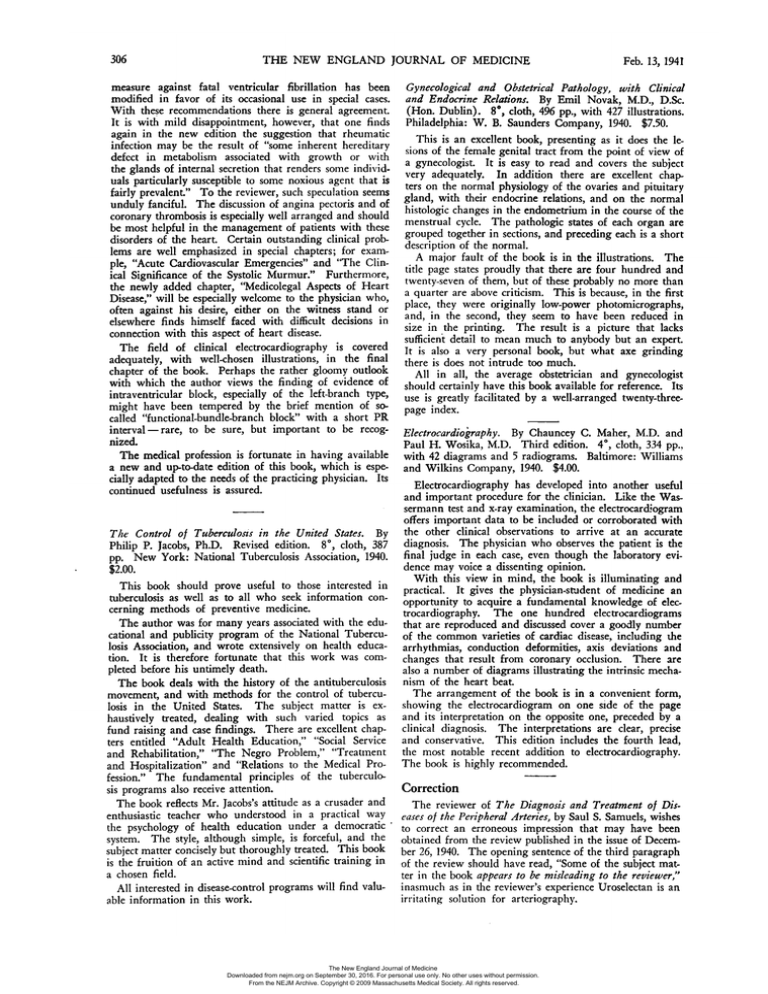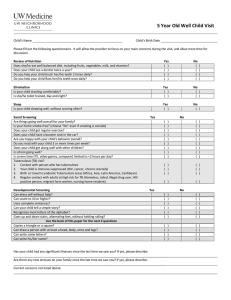
against fatal ventricular fibrillation has been
modified in favor of its occasional use in special cases.
With these recommendations there is general agreement.
It is with mild disappointment, however, that one finds
again in the new edition the suggestion that rheumatic
infection may be the result of "some inherent hereditary
defect in metabolism associated with growth or with
the glands of internal secretion that renders some individuals particularly susceptible to some noxious agent that is
fairly prevalent." To the reviewer, such speculation seems
unduly fanciful. The discussion of angina pectoris and of
coronary thrombosis is especially well arranged and should
be most helpful in the management of patients with these
disorders of the heart. Certain outstanding clinical problems are well emphasized in special chapters; for example, "Acute Cardiovascular Emergencies" and 'The Clinical Significance of the Systolic Murmur." Furthermore,
the newly added chapter, "Medicolegal Aspects of Heart
Disease," will be especially welcome to the physician who,
often against his desire, either on the witness stand or
elsewhere finds himself faced with difficult decisions in
connection with this aspect of heart disease.
The field of clinical electrocardiography is covered
adequately, with well-chosen illustrations, in the final
chapter of the book. Perhaps the rather gloomy outlook
with which the author views the finding of evidence of
intraventricular block, especially of the left-branch type,
might have been tempered by the brief mention of socalled "functional-bundle-branch block" with a short PR
interval rare, to be sure, but important to be recognized.
The medical profession is fortunate in having available
a new and up-to-date edition of this book, which is especially adapted to the needs of the practicing physician. Its
continued usefulness is assured.
measure
—
The Control of Tuberculosis in the United States. By
P. Jacobs, Ph.D. Revised edition. 8\s=deg\, cloth, 387
pp. New York: National Tuberculosis Association, 1940.
Philip
$2.00.
This book should prove useful to those interested in
tuberculosis as well as to all who seek information concerning methods of preventive medicine.
The author was for many years associated with the educational and publicity program of the National Tuberculosis Association, and wrote extensively on health education. It is therefore fortunate that this work was completed before his untimely death.
The book deals with the history of the antituberculosis
movement, and with methods for the control of tuberculosis in the United States. The subject matter is exhaustively treated, dealing with such varied topics as
fund raising and case findings. There are excellent chapters entitled "Adult Health Education," "Social Service
and Rehabilitation," "The Negro Problem," "Treatment
and Hospitalization" and "Relations to the Medical Profession." The fundamental principles of the tuberculosis programs also receive attention.
The book reflects Mr. Jacobs's attitude as a crusader and
enthusiastic teacher who understood in a practical way
the psychology of health education under a democratic
system. The style, although simple, is forceful, and the
treated. This book
subject matter concisely but thoroughlyscientific
training in
is the fruition of an active mind and
a chosen field.
All interested in disease-control programs will find valuable information in this work.
Gynecological and Obstetrical Pathology, with Clinical
and Endocrine Relations. By Emil Novak, M.D., D.Sc.
(Hon. Dublin). 8\s=deg\, cloth, 496 pp., with 427 illustrations.
Philadelphia: W. B. Saunders Company, 1940. $7.50.
This is an excellent book, presenting as it does the lesions of the female genital tract from the point of view of
a gynecologist.
It is easy to read and covers the subject
very adequately. In addition there are excellent chapters on the normal physiology of the ovaries and pituitary
gland, with their endocrine relations, and on the normal
histologie changes in the endometrium in the course of the
menstrual cycle. The pathologic states of each organ are
grouped together in sections, and preceding each is a short
description of the normal.
A major fault of the book is in the illustrations. The
title page states proudly that there are four hundred and
twenty-seven of them, but of these probably no more than
a quarter are above criticism. This is because, in the first
place, they
originally low-power photomicrographs,
second, they seem to have been reduced in
printing. The result is a picture that lacks
sufficient detail to mean much to anybody but an expert.
It is also a very personal book, but what axe grinding
were
and,
in the
size in the
there is does not intrude too much.
All in all, the average obstetrician and gynecologist
should certainly have this book available for reference. Its
use is greatly facilitated by a well-arranged twenty-threepage index.
Electrocardiography. By Chauncey C. Maher, M.D. and
Paul H. Wosika, M.D. Third edition. 4\s=deg\, cloth, 334 pp.,
with 42 diagrams and 5 radiograms. Baltimore: Williams
and Wilkins Company, 1940. $4.00.
Electrocardiography has developed into another useful
and important procedure for the clinician. Like the Wassermann test and x-ray examination, the electrocardiogram
offers important data to be included or corroborated with
the other clinical observations
to
arrive
at an accurate
diagnosis. The physician who observes the patient is the
final judge in each case, even though the laboratory evidence may voice a dissenting opinion.
With this view in mind, the book is illuminating and
practical. It gives the physician-student of medicine an
opportunity to acquire a fundamental knowledge of electrocardiography. The one hundred electrocardiograms
that are reproduced and discussed cover a goodly number
of the common varieties of cardiac disease, including die
arrhythmias, conduction deformities, axis deviations and
changes that result from coronary occlusion. There are
also a number of diagrams illustrating the intrinsic mecha-
nism of the heart beat.
The arrangement of the book is in a convenient form,
showing the electrocardiogram on one side of the page
and its interpretation on the opposite one, preceded by a
clinical diagnosis. The interpretations are clear, precise
and conservative. This edition includes the fourth lead,
the most notable recent addition to electrocardiography.
The book is highly recommended.
Correction
The reviewer of The Diagnosis and Treatment of Disof the Peripheral Arteries, by Saul S. Samuels, wishes
to correct an erroneous impression that may have been
obtained from the review published in the issue of December 26, 1940. The opening sentence of the third paragraph
of the review should have read, "Some of the subject matter in the book appears to be misleading to the reviewer,"
inasmuch as in the reviewer's experience Uroselectan is an
irritating solution for arteriography.
eases
The New England Journal of Medicine
Downloaded from nejm.org on September 30, 2016. For personal use only. No other uses without permission.
From the NEJM Archive. Copyright © 2009 Massachusetts Medical Society. All rights reserved.



